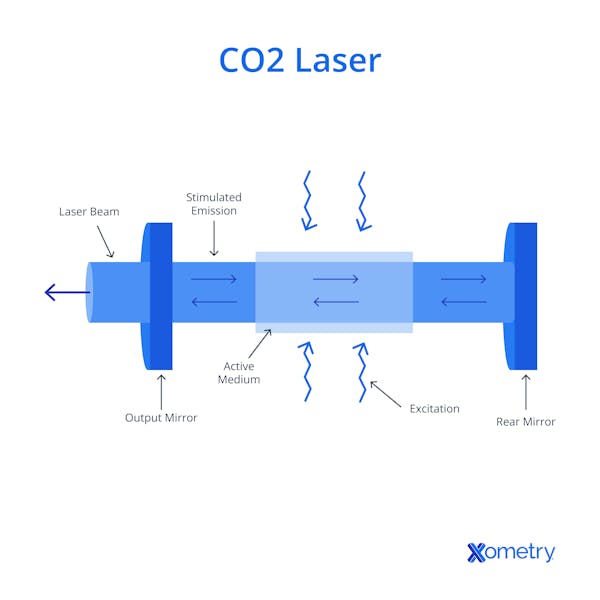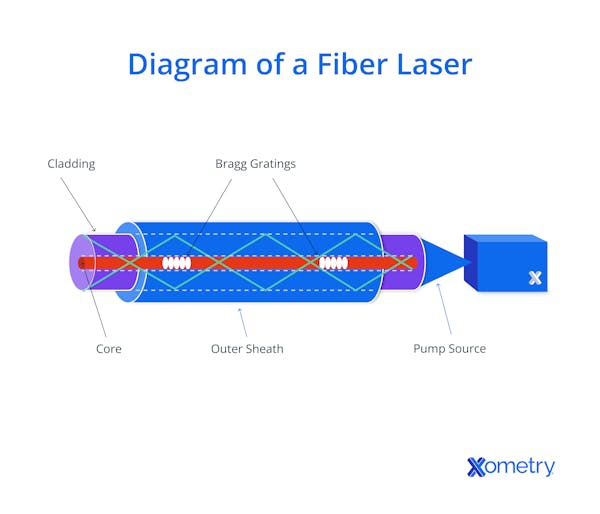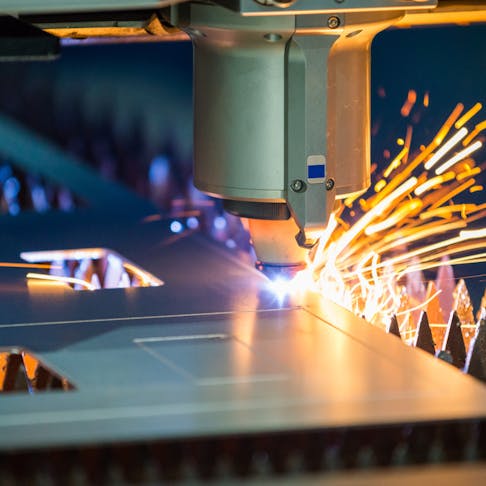Laser cutting is a highly efficient and versatile technology that has revolutionized the automotive industry. It offers a range of benefits that have led to its widespread use. Laser cutters are used in a variety of applications in the automotive industry, including: cutting plastic parts, fabricating metal components, and marking and engraving parts for identification and branding. The production of high-quality automotive parts can be streamlined by combining laser cutting with robotic systems. This makes the automotive industry more efficient and cost-effective.
This article highlights the five benefits of using laser cutting in the automotive industry. These benefits include: precision and clean cuts, versatility in cutting a wide range of materials, compactness, fast processing, high-quality results, and the ability to engrave materials in a single operation.
1. Laser Cutting Produces Clean, Precise Cuts.
Laser cutters use a high-density heat source for cutting which results in precise and clean cuts. The light wave produced by the laser cutter has a wavelength of 10,000 nm. Precision cutting is made possible by the metal's partial absorption of this energy, which leads to a change in the metal's molecular structure. The beam parameter product (BPP) is also used to assess the laser beam quality. The BPP of CO2 lasers, for example, is typically 8–9 mm. This, along with the intensely concentrated heat, accounts for the cut’s near-perfect quality and the method's widespread use in the automotive industry.
Laser cutters are particularly ideal for cutting and sealing airbags. They are considered to be practically error-free in sealing airbag covers, which is why they are now the primary technology used to cut and seal airbags in cars. The laser cutter’s powerful and precisely focused heat is the primary advantage in sealing airbags.
2. Laser Cutting Is Incredibly Versatile, It Can Laser Cut a Wide Range of Materials.
Laser cutters move precisely to cut the outlines that have been programmed into the laser cutting machine since their cutting heads are CNC controlled. This is an extremely useful technology for the automobile sector because it cuts down on production time tremendously and produces consistent parts every time. This also gives this technology the advantage of being very versatile in terms of design flexibility and complexity.
Plastics, fabrics, glass, and rubber are just a few of the materials used in the automotive industry that can all be successfully processed with lasers. Components and materials that have undergone laser processing can be found in practically every part of a standard car, including the exterior as well as the interior. Today, every step of the automotive production process, from initial design and development to final assembly, uses lasers.
3. Laser Cutting Machines Are Extremely Compact When Compared to Other Tools.
The compactness of laser cutters is a key factor in their widespread use and popularity in the automotive industry. The use of the laser cutting machine becomes a crucial output-to-space efficiency for vehicle manufacturers because it is relatively small in comparison to its throughput.
The compact nature of laser cutters allows for easy integration into a manufacturing line. The machines take up minimal space and free up valuable floor space for other equipment. The size advantage of laser cutters also means that they can be used in smaller automotive shops, without sacrificing the precision and accuracy that is needed for quality parts production.
4. Laser Cutting Machines Process Quickly and Produce High-Quality Results.
One of the advantages associated with laser cutters is their fast processing time. They are also known for their high-quality cuts in which both accuracy and precision are realized. These advantages make laser cutters ideal for streamlining the production of automotive parts in all the stages of the manufacturing of the car: from the design phase to part development to assembly.
Lasers frequently function in conjunction with robot systems due to the 3-dimensional nature of some of the items. In certain circumstances, a robot will pick up a part, present it to a stationary processing head, and manipulate it as necessary to finish the cut. As an alternative, the laser might be installed on a robot arm to allow the beam to be guided around the part's 3-dimensional contours.
Combining these two techniques allows for a wide range of processes. It manages the workpiece and the laser head to carry out numerous cutting operations as effectively as possible. Often, multiple laser processes can be carried out within a single robot cell, speeding up production and reducing cycle times.
Lasers aren't just used in mass production, however. They are also being used in high-end, custom car manufacture, where throughput is low and some tasks are still done by hand. Here, the goal is to increase processing quality, repeatability, and dependability rather than to scale up or speed up production. This will lower rejection rates and cut down on the waste of expensive materials. This capability makes laser cutters ideal for both small-scale and large-batch productions.
5. Laser Cutting Machines Can Engrave Materials in a Single Operation.
Laser marking/engraving is more cost-effective than other alternatives since it doesn't have the high consumable expenses that come with inkjet printing technology. In most situations, laser cutting creates a mark that is more durable and indelible. Hot stamping provides durability and high-quality marks, but at the sacrifice of flexibility because each mark needs a different die. Contrarily, laser marking is quick, flexible, and adaptable. The information and visuals to be marked can be quickly modified without the need for tool modifications or downtime. For more information, see our guide on Laser Engraving.
What Are the Uses of Laser Cutting in the Automotive Industry?
Laser cutters have a wide range of applications in the automotive industry. These include:
- Plastic Parts. A wide range of plastic components can be cut with laser cutters, including: the bumpers, dashboard and interior panels, license plates, light housings, pillars, spoilers, and trims. A wide range of plastics, including: ABS, acrylic, HDPE, polypropylene, polycarbonate, and TPO can be used to make automotive components. Plastics can be plain or painted. They can also be integrated with other materials, such as: interior pillars covered in fabric and support systems reinforced with carbon or glass fibers. Lasers can be used to trim extra plastic residue from the injection molding process as well as to cut or drill holes for fixing points, switches, parking sensors, lights, and other components.
- Cutting and Sealing Airbags and Seat Belts. Laser cutters are ideal for cutting and sealing airbags without any wear, which is a common problem with other conventional cutting methods. Flat-woven airbag materials must be shaped by laser cutting before being stitched together and are often silicone-coated to achieve the appropriate air permeability. One-piece-woven (OPW) airbags also need to be trimmed, and a laser is the best instrument for the job. Since there is no contact in both situations, handling of the fabric is limited and the silicone coating is less likely to sustain damage, which could jeopardize the airbag's structural integrity.
- Cutting Synthetic and/or Real Leather. Laser cutters are ideal for cutting leather for car seats.
- Fabric. A car's interior normally consists of a variety of textiles; an example includes the upholstery fabric. The kind of fabric and thickness of the cloth will affect the processing speed. However, a more powerful laser will cut at a proportionately faster rate. The majority of synthetic textiles are precisely cut. The edges are sealed to prevent fraying during later stitching and seat assembly.
- Metal Parts. Laser cutters are used to cut different metal parts for cars, including: sheet metal parts (e.g., doors, hoods, body panels, fenders, etc.), engine components (e.g., gears, bearings, and shafts), exhaust systems, and suspension components.
For more information, see our guide on Uses of Laser Cutting.
What Is the Type of Laser Cutting Used in the Automotive Industry?
There are two main types of lasers used in the automotive industry: CO2 lasers and fiber lasers. These lasers offer the right balance of speed, accuracy, and cost-effectiveness for automotive production processes. CO2 laser cutters are used for cutting non-metallic materials such as: plastic, rubber, and fabrics. These machines are also very versatile and can be used to cut intricate shapes and patterns. On the other hand, fiber lasers can cut both metallic and non-metallic materials. They are perfect for high-volume production runs due to their speed, accuracy, and efficiency. Compared to other kinds of laser cutters, they are also low maintenance and energy efficient.
Factors that influence the choice of the laser cutter in the automotive industry include: the type of material being cut, the production volume, and the required level of accuracy and precision. To satisfy the needs of the sector, the laser cutter must also be capable of cutting the material quickly, precisely, and consistently.
For more information, see our guide on Types of Laser Cutters.


An illustration of a CO2 laser
What Are the Manufactured Products Using Laser Cutting in the Automotive Industry?
Some manufactured products using laser cutting in the automotive industry are:
- Bumpers
- Dashboards
- Interior panels
- Car seats
- Doors
- Body panels
- Engine components
How Effective Is Laser Cutting in the Automotive Industry?
The use of laser cutters in the automotive industry has generally been regarded as effective in terms of producing precise, high-quality cuts. Laser cutters offer a fast and efficient means of cutting a wide variety of materials. This leads to improved production times and lower costs. They also offer greater accuracy and consistency than traditional cutting methods, which can reduce the number of errors and defects in the final product. The use of laser cutters can also help to minimize material waste, as precise cuts allow for the efficient use of raw materials. The compact size of laser cutters allows for easy integration into existing production lines and minimizes the required floor space.
Is Laser Cutting the Best Choice for Cutting Materials in the Automotive Industry?
Yes, laser cutters are the best choice for cutting materials in the automotive industry for several reasons. Laser cutting offers unmatched accuracy and precision at a high production rate. They are also a lot safer than alternative open-blade cutting methods. Laser cutters are also compact in size resulting in output-to-space efficiency.
Summary
This article the benefits of laser cutting in the automotive industry, explained what they are, and discussed each of them in detail. To learn more about laser cutting benefits in various industries, contact a Xometry representative.
Xometry provides a wide range of manufacturing capabilities, including sheet cutting and other value-added services for all of your prototyping and production needs. Visit our website to learn more or to request a free, no-obligation quote.
Disclaimer
The content appearing on this webpage is for informational purposes only. Xometry makes no representation or warranty of any kind, be it expressed or implied, as to the accuracy, completeness, or validity of the information. Any performance parameters, geometric tolerances, specific design features, quality and types of materials, or processes should not be inferred to represent what will be delivered by third-party suppliers or manufacturers through Xometry’s network. Buyers seeking quotes for parts are responsible for defining the specific requirements for those parts. Please refer to our terms and conditions for more information.

